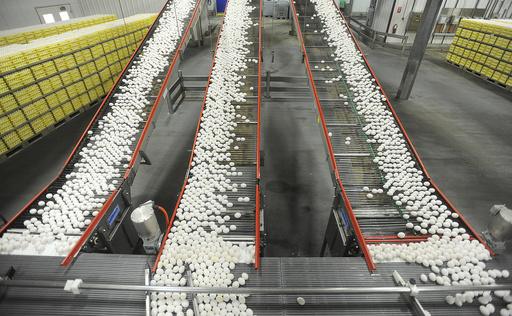
MINNEAPOLIS — As egg prices continue to climb, the Trump administration is set to unveil a new strategy aimed at combatting bird flu that prioritizes vaccination and enhanced biosecurity over the culling of millions of chickens when outbreaks occur.
Kevin Hassett, director of the National Economic Council, highlighted this shift in approach during an appearance on CBS’s “Face the Nation” on Sunday. He stated, “We are looking for better methods, focusing on biosecurity measures and medication,” as opposed to the traditional practice of eradicating all poultry on a farm upon detection of the illness. Hassett mentioned that more details regarding this plan would be shared in the coming week, indicating that collaboration with top experts, including academics, is underway to finalize the strategy.
Typically, when outbreaks of the disease cause significant mortality among chickens or turkeys, officials resort to “depopulation,” meaning they eliminate all birds within the affected farm. This extensive culling process, which has seen millions of chickens killed each month, has dramatically driven up egg prices, contributing to shortages and causing some retailers to impose sales limits. In January, the average price for a dozen Grade A eggs in U.S. cities reached $4.95, with the USDA forecasting a further 20% increase within the year.
While Hassett did not delve into specifics regarding the new policy, he suggested that it could establish a “better, smarter perimeter” surrounding poultry operations. He argued against the logic of slaughtering all chickens in an area when the virus is predominantly spread by wild ducks and geese. Agriculture Secretary Brooke Rollins echoed this sentiment during an interview with “Fox and Friends,” sharing that her first briefing post-confirmation was centered on bird flu, emphasizing the administration’s commitment to ensuring a stable food supply.
The poultry sector has historically been hesitant to implement vaccinations for bird flu, primarily due to potential repercussions in export markets and the associated costs. Many nations that trade with the U.S. often refuse imports from countries that permit vaccinations due to concerns that such measures could obscure the detection of the virus.
Tom Super, a spokesperson for the National Chicken Council—which represents the broiler chicken industry—expressed support for the administration’s aspirations to address food inflation and eliminate regulatory barriers. However, he underscored the necessity for “robust trade protection” to prevent market losses. Leaders from the Congressional Chicken Caucus recently reached out to Rollins, highlighting that although the egg sector has faced the brunt of bird losses, the broiler industry may disproportionately shoulder the negative financial impacts resulting from changes in policy. Since February 2022, USDA data indicates that approximately 77.5% of the nearly 159 million commercial birds lost to avian influenza were egg-laying hens.
Avian influenza vaccines have been available for some time, and recently, the animal health company Zoetis announced it secured a conditional license from the USDA for a new vaccine. The company stated that the decision to implement this vaccine lies with federal authorities in collaboration with the poultry industry. Several other manufacturers are also in the process of developing vaccines.
Dr. Carol Cardona, an expert on bird flu at the University of Minnesota, expressed that enhancing biosecurity to curb cross-contamination and localizing outbreaks to specific barns demands significant on-the-ground efforts. In an interview, she stated, “I’ve seen it work; I’ve also witnessed it fail dramatically in other situations.” To make “precision depopulation” effective, she emphasized the importance of establishing solid barriers to transmission between barns, such as preventing workers from transporting the virus on their clothing or footwear. Workers must be vigilant in detecting early signs of abnormal illnesses in poultry, she added.
Administratively, challenges also arise in vaccinating extensive numbers of birds—effectively 3 million or more at a single egg farm—given that current vaccine options require needles for injection. Cardona noted that farms may focus vaccinations on incoming pullets instead of their entire flock. The development of vaccines that could be efficiently administered through a farm’s water supply would require significant advancements, and without an existing market for such vaccines, the incentive for their development remains low. “While we aren’t at the technology level we aspire to be, it reflects where we currently stand,” Cardona remarked.

